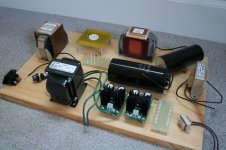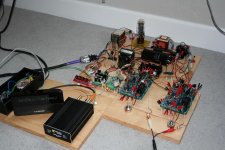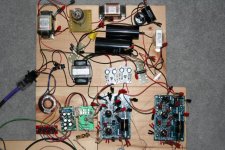The other components in the power supply are the 4 100 ohm resistors to create the virtual center tap for the 6.3 volt supplies, and the voltage dividers to get the B+/4 voltage potential.
These will all be 2 watt KOA SPR2 resistors, otherwise known as Kiwame.
Question for the group: I am not sure whether I need the 0.1 uF cap that Broskie shows in the manual from the virtual center tap to ground. Do I? He mentions different approaches to biasing the heater supply voltages -- I'm not sure if the 0.1 uF cap is needed for my scheme, or if it is just for the floating heater supply scheme.
These will all be 2 watt KOA SPR2 resistors, otherwise known as Kiwame.
Question for the group: I am not sure whether I need the 0.1 uF cap that Broskie shows in the manual from the virtual center tap to ground. Do I? He mentions different approaches to biasing the heater supply voltages -- I'm not sure if the 0.1 uF cap is needed for my scheme, or if it is just for the floating heater supply scheme.
One potential problem with the Angela power transformer is that the 6.3 volt secondary is only 3.5 amps. The 6CG7s/5687s just by themselves will draw 3 amps. This should be ok for AC heaters but with DC there is probably not enough headroom. So in that case a separate filament transformer would be necessary.
I happen to have a filament transformer in my parts drawer, so I'll still consider the Angela. Others may have different requirements.
One nice thing about the Angela transformer is that in addition to the 320 volt secondary there is a 380 volt center tapped secondary. This could come in handy if using an LC-Regulator configuration, since a shunt regulator could easily burn the extra volts.
I also notice there is a 55 volt bias tap on the Angela transformer. This could come in handy to dispense with the B+/4 voltage divider resistors, it seems close enough.
That brings up another question. The Lundahl LL1683 transformer has a 48 volt secondary. I wonder if that be used for biasing the heater supplies? It is two wires out, probably 24 volts each, so not quite like the Angela bias tap which could just be run to the heater supply virtual center tap.
Thinking about this more, the 55 volt bias tap is AC, not DC. I have no idea if this would work plugged into the virtual center tap. Thoughts?
I happen to have a filament transformer in my parts drawer, so I'll still consider the Angela. Others may have different requirements.
One nice thing about the Angela transformer is that in addition to the 320 volt secondary there is a 380 volt center tapped secondary. This could come in handy if using an LC-Regulator configuration, since a shunt regulator could easily burn the extra volts.
I also notice there is a 55 volt bias tap on the Angela transformer. This could come in handy to dispense with the B+/4 voltage divider resistors, it seems close enough.
That brings up another question. The Lundahl LL1683 transformer has a 48 volt secondary. I wonder if that be used for biasing the heater supplies? It is two wires out, probably 24 volts each, so not quite like the Angela bias tap which could just be run to the heater supply virtual center tap.
Thinking about this more, the 55 volt bias tap is AC, not DC. I have no idea if this would work plugged into the virtual center tap. Thoughts?
Here is a picture of the power supply prototype with parts laid out on the board. Swapping between the Lundahl and Angela power transformers will give possible 260, 320, and 380 volts AC input. This seems like a good range as a test bed for various vacuum tube output stages I might want to try. For the Aikido, it will allow voltages from 200 to 300+ volts:
Attachments
Cappy,
Looks great, so far. I have to remark that those Obbligato power filter caps are just freakin' huge. My own Aikido build is nearing completion, but being my first build of much of anything it's turned out much simpler than your own efforts. I built a Maida-type regulator and have eschewed any choke on the input.
The results, so far, have been great. My question to you is, given the very good PSNR figures on the Aikido, why spend so much effort in reducing noise that will be nulled by the topology anyhow? Note that this isn't meant to bait you, I'm genuinely curious.
--k
Looks great, so far. I have to remark that those Obbligato power filter caps are just freakin' huge. My own Aikido build is nearing completion, but being my first build of much of anything it's turned out much simpler than your own efforts. I built a Maida-type regulator and have eschewed any choke on the input.
The results, so far, have been great. My question to you is, given the very good PSNR figures on the Aikido, why spend so much effort in reducing noise that will be nulled by the topology anyhow? Note that this isn't meant to bait you, I'm genuinely curious.
--k
Kool,
That's a reasonable question.
First, I'm becoming a big believer in having the best power supply possible, based on my own experiments and listening to other people's stuff. And that reducing ripple is important, but there is more to it than that - current delivery, impulse behavior, no hash from power supply back on power lines, no electrolytic caps, etc. etc. The Aikido will null ripple, but I think that other attributes of a good power supply are worth pursing and will positively effect the Aikido. My power supply definitely isn't state of the art on ripple reduction anyway.
Last weekend at VSAC I listened to two of Jeffrey Jackson's amps with power supplies that make my power supply look like a children's toy. And both those amps sounded tremendous.
Secondly, I don't know much about the subject, so my goal is just to learn more -- it's possible your compact power supply would beat or match mine. Knowing that in itself I would find an interesting result. I just read a quote I liked that is somewhat applicable:
"An expert is a man who has made all the mistakes which can be made, in a narrow field." -- Niels Bohr
So is a choke input supply really worth the trouble? Part of this exercise is to determine the answer to that question empirically. Also, how can I bullshi* effectively in audio forums if I haven't made the experiments.
Second, I've been wanted to explore the area of choke input supplies for a while, since they don't often appear in commercial gear, just for fun.
Third, I am aiming for this power supply to be a semi-universal solution for my future projects such that I can just change a few things and get the power I need for a variety of B+ voltages. For example, I've been wanting to try a DHT Dac output stage --- now that will require some clean power.
One of Jeffrey's amp prototypes. Note, this is honkin' bigger than it looks in the picture:
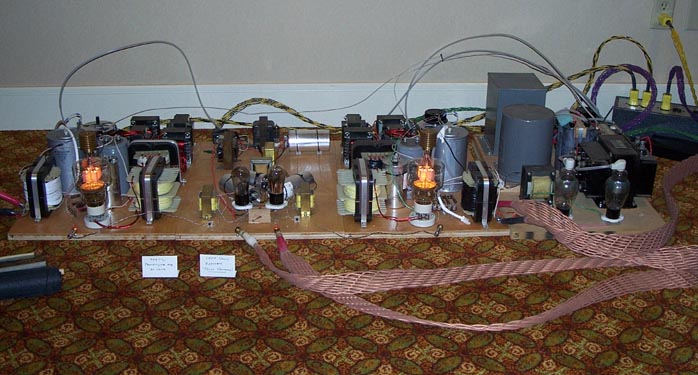
Here is another picture -- for scale that is a subwoofer in the corner with an 18" Hartley driver:
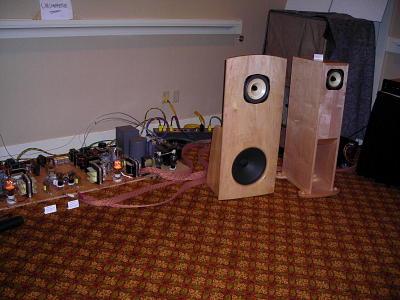
Cheers, Bill
That's a reasonable question.
First, I'm becoming a big believer in having the best power supply possible, based on my own experiments and listening to other people's stuff. And that reducing ripple is important, but there is more to it than that - current delivery, impulse behavior, no hash from power supply back on power lines, no electrolytic caps, etc. etc. The Aikido will null ripple, but I think that other attributes of a good power supply are worth pursing and will positively effect the Aikido. My power supply definitely isn't state of the art on ripple reduction anyway.
Last weekend at VSAC I listened to two of Jeffrey Jackson's amps with power supplies that make my power supply look like a children's toy. And both those amps sounded tremendous.
Secondly, I don't know much about the subject, so my goal is just to learn more -- it's possible your compact power supply would beat or match mine. Knowing that in itself I would find an interesting result. I just read a quote I liked that is somewhat applicable:
"An expert is a man who has made all the mistakes which can be made, in a narrow field." -- Niels Bohr
So is a choke input supply really worth the trouble? Part of this exercise is to determine the answer to that question empirically. Also, how can I bullshi* effectively in audio forums if I haven't made the experiments.
Second, I've been wanted to explore the area of choke input supplies for a while, since they don't often appear in commercial gear, just for fun.
Third, I am aiming for this power supply to be a semi-universal solution for my future projects such that I can just change a few things and get the power I need for a variety of B+ voltages. For example, I've been wanting to try a DHT Dac output stage --- now that will require some clean power.
One of Jeffrey's amp prototypes. Note, this is honkin' bigger than it looks in the picture:

Here is another picture -- for scale that is a subwoofer in the corner with an 18" Hartley driver:

Cheers, Bill
Yeah, 1000 volts exposed.
I think if hotel security knew what was going on we would have seen Defcon 1 type behavior.
I pulled those photos from:
http://www.jenalabs.com/shows/shows.html
I think if hotel security knew what was going on we would have seen Defcon 1 type behavior.
I pulled those photos from:
http://www.jenalabs.com/shows/shows.html
You're collecting an audience
I just got my 5687 Aikido kit in the mail and am planning to use it as a DAC output stage, just like you are. I like the idea of an inductor-based PS; some claim that is one of the reasons why the Ayre gear sounds so good.
I want you to finish this project without trauma, so before going farther I suggest you listen to this lecture on Electricity.
%^>
I just got my 5687 Aikido kit in the mail and am planning to use it as a DAC output stage, just like you are. I like the idea of an inductor-based PS; some claim that is one of the reasons why the Ayre gear sounds so good.
I want you to finish this project without trauma, so before going farther I suggest you listen to this lecture on Electricity.
%^>
Cappy said:Hmm, maybe a little obscure.
Dackido?
Sounds a little close to a concentration camp....
Hi Cappy!
Cool thread.
Very interesting topics regarding your different set-ups of PSU´s. I don´t know how to determine the Q of a PSU but if anybody knows I think it could be very interesting with an example of a PSU with a Q = 0,5.
I am building an Aikido as well. Mine is a line amp and not for a DAC.
I call it My-Kido (or Maybe it should be My Kid´o)
Kind regards
Karsten
Cool thread.
Very interesting topics regarding your different set-ups of PSU´s. I don´t know how to determine the Q of a PSU but if anybody knows I think it could be very interesting with an example of a PSU with a Q = 0,5.
I am building an Aikido as well. Mine is a line amp and not for a DAC.
I call it My-Kido (or Maybe it should be My Kid´o)
Kind regards
Karsten
Karsten,
Keep us posted on your Aikido project.
I'd like to know how to calculate Q myself. I am wrestling with a Spice program, but I haven't got very far yet. I'm still trying to figure out how to simulate a current sink...
In particular I would like to see a graph of output impedance vs. frequency of the power supply. Having a favorable output impedance might not occur across a wide bandwidth. This apparently can cause resonances.
****
Boris,
Ok then, but sounds more like a Mexican or Japanese salty snack food to me.
Keep us posted on your Aikido project.
I'd like to know how to calculate Q myself. I am wrestling with a Spice program, but I haven't got very far yet. I'm still trying to figure out how to simulate a current sink...
In particular I would like to see a graph of output impedance vs. frequency of the power supply. Having a favorable output impedance might not occur across a wide bandwidth. This apparently can cause resonances.
****
Boris,
Ok then, but sounds more like a Mexican or Japanese salty snack food to me.
I got the project up and running today with the Twisted Pear Buffalo DAC. There have been only a few issues so far. A visual inspection of the running supply noted no obvious resonances that caused the board or parts to shake uncontrollably, such as occurred with the first Tacoma Narrows Bridge in 1940.
Here Be Alligator (clips):
Here Be Alligator (clips):
Attachments
The B+ power supply came up perfectly the first time. The first issue was with the heater supplies -- I couldn't run more than 1.2 amps on each heater supply without making the voltage stay pegged at 5.6 volts - it could go no higher. So I swapped out the 6CG7s for position 1 and put in some 6n23p-evs. This got the voltage up to my target 6.2 volts. By the way, one nice feature of the Tentlabs IDHT supplies is the ability to dial in whatever voltage is desired. Position 2 is currently running Tung Sol 5687s. The filament transformer is putting out 6.95 volts under load, probably not enough for the TentLabs supplies at 1.5 amps. I'll get a 10v filament supply shortly and use some drop resistors. That way I can play with 6cg7s and 6n1ps in position 1. Later I will use the transformer for my next project in the fall, which is a 10y output stage using the same "semi-universal" power supply.
Second, getting the cathode resistor values to get Broskie's suggested 10 mA on 6n23ps and 20 ma on 5687s took a bit of tweaking. Currently the B+ is 210 volts. The resistors are placed in parallel to get appropriate values, a mix of Shinkoh tantalums and Rikens on position 1, Shinkohs and IRCs on position 2. I can tell I'm going to need more resistor values since I'll be playing with a lot of different tube types and B+ voltages.
Third, dealing with the plethora of alligator clips on the Aikido is a bit hectic. So far so good, though.
I am running right now throught $59.95 Cambridge Audio computer speakers but I can tell it is going to sound ***NICE***. Currently Rosanne is singing sweetly but throatily about her Dad. The next step is to move everything into the listening room.
Those pots are not volume controls, they are there to tweak the power supply noise to get the lowest PSRR.
The output of the Buffalo is going through Mill resistors for passive I/V, and then on directly into the Aikido position 1 grid. The grid stopper in combination with the Miller capacitance of the tube is providing a mild -6 db low pass RC filter. There is no other post-DAC analog filter at this point. The DC offset of the ESS Sabre didn't seem to change the bias point of the 6n23ps.
Second, getting the cathode resistor values to get Broskie's suggested 10 mA on 6n23ps and 20 ma on 5687s took a bit of tweaking. Currently the B+ is 210 volts. The resistors are placed in parallel to get appropriate values, a mix of Shinkoh tantalums and Rikens on position 1, Shinkohs and IRCs on position 2. I can tell I'm going to need more resistor values since I'll be playing with a lot of different tube types and B+ voltages.
Third, dealing with the plethora of alligator clips on the Aikido is a bit hectic. So far so good, though.
I am running right now throught $59.95 Cambridge Audio computer speakers but I can tell it is going to sound ***NICE***. Currently Rosanne is singing sweetly but throatily about her Dad. The next step is to move everything into the listening room.
Those pots are not volume controls, they are there to tweak the power supply noise to get the lowest PSRR.
The output of the Buffalo is going through Mill resistors for passive I/V, and then on directly into the Aikido position 1 grid. The grid stopper in combination with the Miller capacitance of the tube is providing a mild -6 db low pass RC filter. There is no other post-DAC analog filter at this point. The DC offset of the ESS Sabre didn't seem to change the bias point of the 6n23ps.
Attachments
It turns out the Lundahl LL1683 transformer is fairly flexible on output voltages. The normal output is 250 vdc at 115/230 vac. However, there is also a 48vac secondary. I wondered if this tap could be used for buck or boost, and Kevin Carter at K&K replied in the affirmative.
He wrote to me when I asked about buck or boost:
"So long as you stay within the 100mA rating, it can. BTW, the 250 volt windings will support 100mA with no problem, too, in spite of the 80mA rating. This transformer was designed to my specs and the 48v winding was included for microphone phantom power supplies."
So this means the transformer can be used at 200v, 250v, and 300v out. The one caveat is that this is for bridge mode only, so four solid state diodes or two tube rectifiers. A hybrid tube/cree bridge could be done also, with a single tube rectifier and two diodes. I've got the parts to try this now since I'm doing the full wave stuff anyway.
Another tranformer possibility, and definitely the most bling looking one for top of chassis mounting, is
James.
He wrote to me when I asked about buck or boost:
"So long as you stay within the 100mA rating, it can. BTW, the 250 volt windings will support 100mA with no problem, too, in spite of the 80mA rating. This transformer was designed to my specs and the 48v winding was included for microphone phantom power supplies."
So this means the transformer can be used at 200v, 250v, and 300v out. The one caveat is that this is for bridge mode only, so four solid state diodes or two tube rectifiers. A hybrid tube/cree bridge could be done also, with a single tube rectifier and two diodes. I've got the parts to try this now since I'm doing the full wave stuff anyway.
Another tranformer possibility, and definitely the most bling looking one for top of chassis mounting, is
James.
What about the Hashimoto PT-100? Not cheap, but gorgeous and built like a tank.
Info at: http://www.tube-amps.net
No affiliation, just passing along a favorite.
-- Jim
Info at: http://www.tube-amps.net
No affiliation, just passing along a favorite.
-- Jim
Jim,
Thanks for the link. Those Hashimotos are cool, kind of a Yves St. Laurent look compared to the Jame's Versace.
For choke input and 6cg7s at 250-300v the PT-160 or PT-220 might work better.
I was able to move the project into the main listening room. The 205v 6n23p-ev/5687 10mA/20mA Dackido is sure sounding good.
Thanks for the link. Those Hashimotos are cool, kind of a Yves St. Laurent look compared to the Jame's Versace.
For choke input and 6cg7s at 250-300v the PT-160 or PT-220 might work better.
I was able to move the project into the main listening room. The 205v 6n23p-ev/5687 10mA/20mA Dackido is sure sounding good.
At this point I see no need to add a discrete analog post-dac filter as the Aikido's "implicit" one seems to be working well.
I mentioned that it is a slow rolloff -6 db filter in an earlier post. Thinking about the filtering in the shower this morning, I realized it was actually steeper. The Aikido has two stages, so I believe it is really a two pole RCRC filter. This is a nice "feature" of the Aikido for a DAC output stage.
The Buffalo has smooth but resolved and extended highs. No 3-5k glare. Violins have bite but are not boorish. Buffalo basically does boffo upper midrange/treble.
I attribute this not only the the Sabre chip, but also to the Buffalo's fine layout, parts choices, and power supply. The power supply is an amazing bargain for a dual CLRC supply.
Russ and Brian's Twisted Pear products are kind of like the 47 labs of the DIY world using super short signal paths and so on. The snap together industrial design is great: Lego for DIY audiophiles.
For example, I can exchange the Buffalo for the pcm1794 based COD in my system in about 5 minutes. If someone wants to experiment with a different power supply -- no problem, just plug it in. Want I2S instead of SPDIF? - no problem there either.
I mentioned that it is a slow rolloff -6 db filter in an earlier post. Thinking about the filtering in the shower this morning, I realized it was actually steeper. The Aikido has two stages, so I believe it is really a two pole RCRC filter. This is a nice "feature" of the Aikido for a DAC output stage.
The Buffalo has smooth but resolved and extended highs. No 3-5k glare. Violins have bite but are not boorish. Buffalo basically does boffo upper midrange/treble.
I attribute this not only the the Sabre chip, but also to the Buffalo's fine layout, parts choices, and power supply. The power supply is an amazing bargain for a dual CLRC supply.
Russ and Brian's Twisted Pear products are kind of like the 47 labs of the DIY world using super short signal paths and so on. The snap together industrial design is great: Lego for DIY audiophiles.
For example, I can exchange the Buffalo for the pcm1794 based COD in my system in about 5 minutes. If someone wants to experiment with a different power supply -- no problem, just plug it in. Want I2S instead of SPDIF? - no problem there either.
Cappy,
When you said:
For choke input and 6cg7s at 250-300v the PT-160 or PT-220 might work better.
Can you tell me a bit more about this? Do you really need that much current? With something like the PT-100 or even the PT-60, there seems ample current capacity and enough voltage overhead for SS or even possibly a 5AR4 rectifier into a lowish DCR choke. Just guessing though.
I'm also really interested to hear what kinds of power supplies people have used for the Aikido boards as head amps, and where they set the operating points. Sometime down the road when a few other projects are done, the idea of a 6CG7/6H30 Aikido mono board based headamp looks interesting (cans would be HD-650s).
But back to the original question, I was planning on using a PT-100 or rough equivalent for a 45 SET I'm starting to put together, and which wants a B+ of around 320 vdc and about 80mA max current draw. Just want to make sure I'm not missing something obvious here.
Thanks,
Jim
When you said:
For choke input and 6cg7s at 250-300v the PT-160 or PT-220 might work better.
Can you tell me a bit more about this? Do you really need that much current? With something like the PT-100 or even the PT-60, there seems ample current capacity and enough voltage overhead for SS or even possibly a 5AR4 rectifier into a lowish DCR choke. Just guessing though.
I'm also really interested to hear what kinds of power supplies people have used for the Aikido boards as head amps, and where they set the operating points. Sometime down the road when a few other projects are done, the idea of a 6CG7/6H30 Aikido mono board based headamp looks interesting (cans would be HD-650s).
But back to the original question, I was planning on using a PT-100 or rough equivalent for a 45 SET I'm starting to put together, and which wants a B+ of around 320 vdc and about 80mA max current draw. Just want to make sure I'm not missing something obvious here.
Thanks,
Jim
- Status
- This old topic is closed. If you want to reopen this topic, contact a moderator using the "Report Post" button.
- Home
- Amplifiers
- Tubes / Valves
- Y A A B - Yet Another Aikido Build
